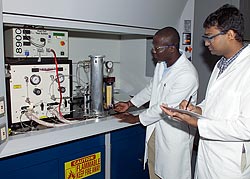Research Project to Help Develop Higher-Performance Fuel Cells for Aerospace Power Needs
Jim Fenton and Nazim Muradov are leading a new research project to
optimize polymer electrolyte membrane fuel cells (PEMFC) for aerospace
auxiliary power applications, thanks to a $70,000 grant from the State
University System of Florida (SUS).
The project, part of the NASA-funded SUS Florida Turbine Initiative,
will help develop fuel cells as a power source for a wide range of
applications. NASA is especially interested in PEMFCs as the
main source of auxiliary power in aerospace applications where key
requirements are fuel cell efficiency, power density and fuel flexibility.
 |
Franklyn Smith, left, and Vishal
Mittal test a PEM fuel cell coupled with a hydrocarbon
reformer.
|
Muradov pointed out that what makes this new project unique is that “it
involves an integration of two novel devices – a pyrolytic fuel
processor (PFP) which was developed and patented at FSEC, and a high-temperature
PEMFC, an area where FSEC is conducting pioneering research.” He
added that “operation of PEMFC at high temperatures increases
the overall system efficiency, reduces the effects of carbon monoxide
poisoning of the anode from impure hydrogen feed, and accelerates
the electrochemical reaction kinetics.” With the current
PEMFC technology, operating at low temperatures and high relative
humidity results in maximum power density but decreases the overall
system efficiency because of heat and water management issues. FSEC
is currently the lead organization on the research and development
activity for the U.S. Department of Energy’s high temperature,
low relative humidity membrane program.
The new research program will focus on the combination of the PFP
with PEMFC to achieve higher performance by solving the daunting problem
associated with hydrogen storage; obviating the need for external
humidification of hydrogen gas; eliminating energy intensive gas conditioning
and purification steps, and offering simplicity.
Muradov added that the development of the PFP-PEMFC power generator
with increased energy efficiency and power density would be beneficial
not only to aerospace, but also to a variety of terrestrial applications.
